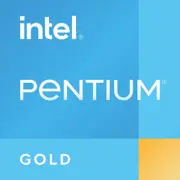Intel Pentium Gold G5620

Intel Pentium Gold G5620: processore budget per compiti di base nel 2025
Aggiornato: aprile 2025
1. Caratteristiche principali: architettura e prestazioni
Architettura e processo produttivo
Il processore Intel Pentium Gold G5620 appartiene alla generazione Coffee Lake (2018-2019) ed è realizzato con un processo produttivo a 14 nm. Nonostante l'età dell'architettura, rimane attuale per assemblaggi di fascia economica grazie al basso consumo energetico (TDP 54 W) e al supporto per Hyper-Threading: 2 core e 4 thread.
Caratteristiche chiave
- Cache L3: 4 MB — sufficiente per compiti semplici, ma limitato per lavorazioni multithread avanzate.
- Grafica integrata: Intel UHD Graphics 630 con frequenza di base di 350 MHz (fino a 1,15 GHz in modalità Turbo). Supporta 4K tramite HDMI/DisplayPort, ma è insufficiente per il gaming.
- Prestazioni: Nel benchmark Geekbench 6, il processore ottiene 763 punti in modalità single-core e 1456 in multi-core. Questo rappresenta un livello adeguato per compiti d'ufficio e un multitasking leggero.
Esempio pratico: Per lavorare con documenti, browser (10+ schede) e guardare video in 1080p, il processore non presenta lag. Tuttavia, avviando Photoshop + Zoom + Spotify possono verificarsi dei rallentamenti.
2. Schede madri compatibili
Socket e chipset
Il processore utilizza il socket LGA 1151-v2, compatibile solo con chipset della serie 300:
- H310/B360/H370: Schede madri economiche (ad esempio, ASRock H310CM-HDV, ~$60–70). Adatte per assemblaggi di base, ma prive di opzioni di overclock e con il numero minimo di porte.
- Z370/Z390: Schede per appassionati (ASUS Prime Z390-P, ~$120–140). Eccessive per il Pentium, ma consentono di installare un CPU più potente in futuro.
Considerazioni sulla scelta
- Controlla la versione del BIOS: le vecchie schede madri potrebbero necessitare di un aggiornamento per funzionare con Coffee Lake.
- Nel 2025, non vengono più prodotte nuove schede madri per LGA 1151-v2. Cerca giacenze nei magazzini o opzioni refurbished.
3. Memoria supportata
Tipi e modalità
Il processore supporta DDR4-2400 MHz in modalità dual-channel. Il supporto per DDR5 non è presente.
- Dimensione consigliata: 8–16 GB. Ad esempio, un kit 2x8 GB Crucial DDR4-2400 (~$40–50).
- Importante: Le schede madri H310/B360 spesso hanno solo due slot per la memoria.
Esempio: Per Windows 11 e applicazioni d'ufficio, 8 GB sono sufficienti, ma per un utilizzo più confortevole con Chrome + applicazioni, meglio optare per 16 GB.
4. Raccomandazioni per i blocchi alimentatori
Calcolo della potenza
Con un TDP di 54 W, il Pentium Gold G5620 non richiede un alimentatore potente. Anche un alimentatore budget da 400 W è più che sufficiente.
- Senza scheda video discreta: 300–400 W (ad esempio, EVGA 400 N1, ~$35).
- Con scheda video: Per una GPU di livello NVIDIA GTX 1650 (TDP 75 W), opta per un alimentatore da 500 W (Corsair CX550, ~$60).
Consiglio: Non risparmiare sull'alimentatore. Modelli difettosi possono danneggiare i componenti. Cerca certificazioni 80+ Bronze o superiori.
5. Vantaggi e svantaggi del processore
Vantaggi:
- Prezzo basso (~$70–80 nel 2025).
- Efficienza energetica: adatto per assemblaggi compatti e silenziosi.
- Grafica integrata: non richiede una scheda video separata per compiti di base.
Svantaggi:
- Solo 2 core: prestazioni multithread limitate.
- Nessun supporto per PCIe 4.0: la velocità massima degli SSD è limitata.
- Piattaforma obsoleta: l'aggiornamento è possibile solo fino ai processori di 8ª/9ª generazione.
6. Scenari di utilizzo
Ufficio e multimedia
- Lavoro con documenti, browser, video in 1080p.
- Collegamento a un televisore come centro multimediale (4K HDR tramite HDMI 2.0).
Giochi leggeri
- CS:GO, Dota 2, Minecraft con impostazioni basse (30–50 FPS).
- Per giochi come Cyberpunk 2077 o Elden Ring è necessaria una scheda video discreta (ad esempio, GTX 1660).
Cosa non aspettarsi:
- Streaming, montaggio video, rendering 3D.
7. Confronto con concorrenti
AMD Ryzen 3 3200G (4 core/4 thread, Vega 8, ~$90):
- Migliore in compiti multithread (+20% in Cinebench R23).
- La grafica Vega 8 è superiore all'UHD 630 del 30–40%.
Intel Core i3-10100 (4 core/8 thread, ~$110):
- Prestazioni superiori nei giochi (+35% in Geekbench 6 Multi-Core).
- Supporto per DDR4-2666 e PCIe 3.0.
Conclusione: Il Pentium G5620 è vantaggioso solo con un budget ristretto. Se puoi aggiungere $20–30, è meglio optare per Ryzen 3 o Core i3.
8. Consigli pratici per l'assemblaggio
Configurazione budget (esempio):
- Scheda madre: ASRock B360M-HDV (~$65).
- Memoria: Patriot Signature 16 GB DDR4-2400 (~$45).
- Disco: Kingston A400 480 GB SSD (~$35).
- Alimentatore: EVGA 450 BR (~$40).
- Case: Cooler Master MasterBox Q300L (~$50).
Ottimizzazioni:
- Per un funzionamento silenzioso, sostituisci il cooler di serie con un Deepcool GAMMAXX 400 (~$20).
- Se serve una grafica più potente, aggiungi una GTX 1050 Ti usata (~$80).
9. Conclusione: a chi si adatta il Pentium Gold G5620?
Questo processore è la scelta ideale per chi cerca un PC economico e affidabile per compiti di base:
- Lavoratori d'ufficio.
- Utenti che assemblano un centro multimediale o un PC per studio.
- Proprietari di sistemi datati che aggiornano la CPU senza cambiare la scheda madre.
Perché sceglierlo?
- Prezzo inferiore a $80.
- Non richiede una scheda video discreta.
- Sufficiente per compiti quotidiani nel 2025.
Tuttavia, se il budget lo consente, è meglio considerare APU più moderne da AMD o Core i3 di 10ª generazione: offriranno un margine di prestazioni per il futuro.
I prezzi sono aggiornati all'aprile 2025 per i nuovi dispositivi. I modelli menzionati potrebbero essere stati dismessi — cerca equivalenti con caratteristiche simili.
Di base
Specifiche della CPU
Specifiche della memoria
Specifiche della GPU
Varie
Classifiche
Rispetto ad altre CPU
Condividi sui social media
Oppure linkaci
<a href="https://cputronic.com/it/cpu/intel-pentium-gold-g5620" target="_blank">Intel Pentium Gold G5620</a>